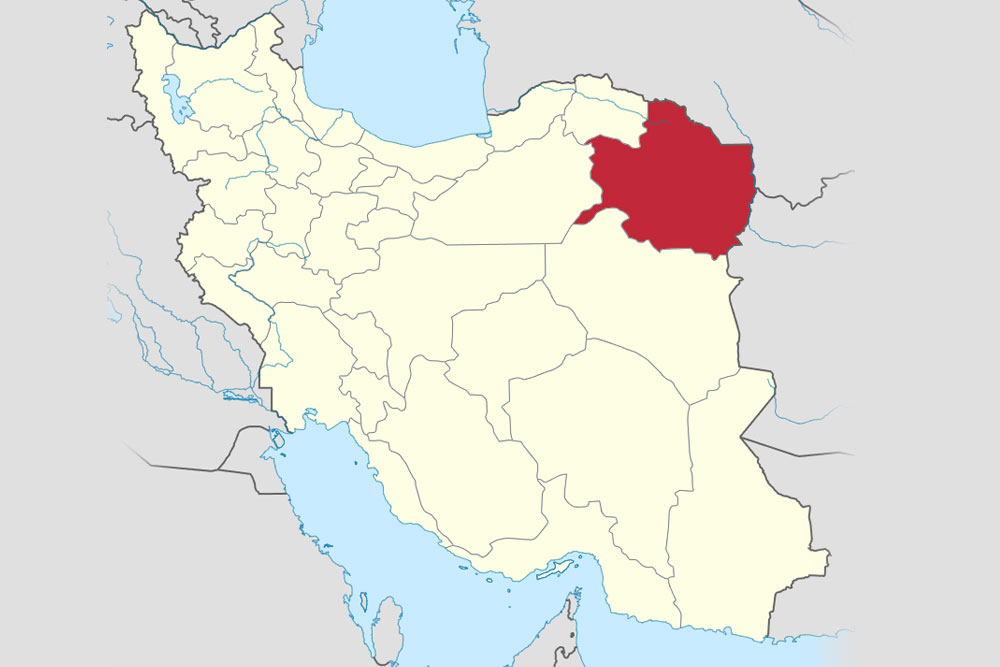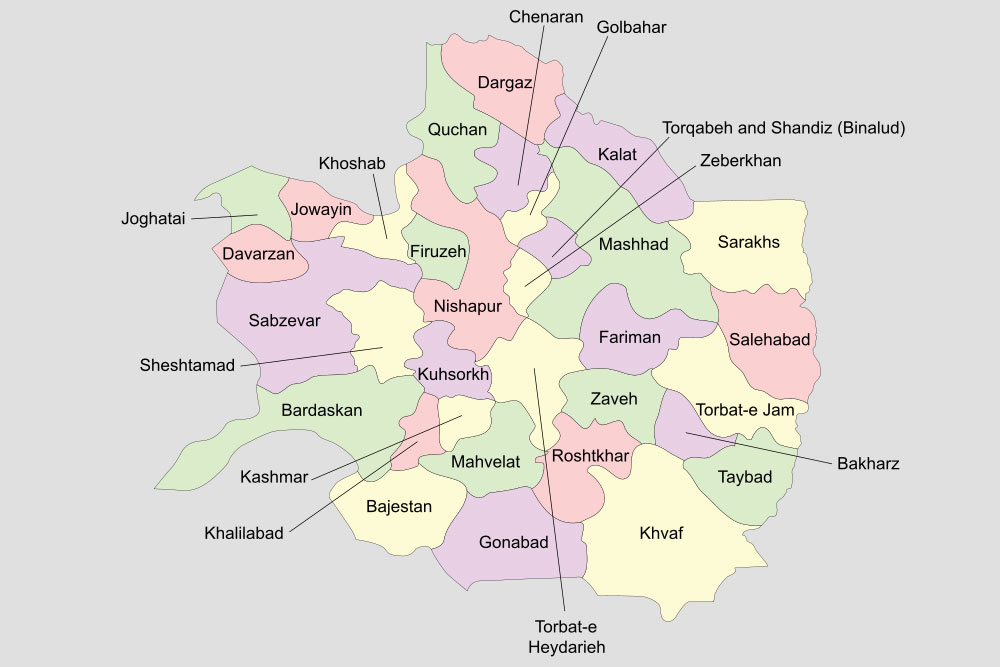
About Khorasan Razavi
Khorasan Razavi is a province located in the north-east of Iran. Mashhad -the 2nd largest citiy of the country after capital Tehran- is the center city of the province. Area: 118851 sq. kilometer ( 7.3 % of the total area of the country). 833.6 kilometer common borders with Afghanistan to the east and Turkmenistan to the north. Population: According to the 2012 national census the population exceeds 6 million. They reside in 28 towns, 70 districts and 72 provincial towns.
The main products:
- – Industry: Automobile manufacturing, parts manufacturing, iron ore concentrate, steel, food industries, cement, textile, tile and ceramic, porcelain, machine made rugs.
- – Mining: Iron ore, silica, dimension stones, industrial clay (molybdenum – kaolin), rare metals (gold, lead, etc).
- – Agriculture: Saffron, wheat, pistachio, almond, sugar beet, medicinal herbs.
- – Animal Husbandry: Sheep, cattle, poultry.
- – Handicrafts: Handmade textiles (carpets, kilim, felt, fur clothing, etc.), stone carving (turquoise jewelry, stone vessels, decorative sculptures), mosaics and scrimshaw.
Transportation:
- – Mashhad Shahid Hashemi Nejad International Airport is connected to 19 foreign cities in 11 countries around the world. It also serves 18 domestic routes and supports nine active foreign airlines.
- – Mashhad is the hub for Central Asia-Europe international railway corridor and international north-south railway corridor (Sarakhs border with Chabahar and Bandar Abbas). It has also established a rail connection with country’s southern, northern, eastern and western boundaries.
- – Mashhad connects west to east and north to south by transit roads; it has a road junction linking all parts of the country as well.
- – Customs:There are 3 common boundary customs with the Republic of Turkmenistan, including Sarakhs in the north of the province,
- – Bajgiran and Lotfabad in the west region and one customs with the Republic of Afghanistan in Dogharoon at the eastern region of the province.
- – Special Zones: It involves two special economic zones in Sarakhs and Dogharoon, near the Turkmenistan and Afghanistan borders respectively.
- – Consulates: 8 countries including Saudi Arabia, Afghanistan, Pakistan, Iraq, Turkey, Turkmenistan, Kyrgyzstan and Tajikistan (Bureau of Consular Affairs) have consulates in Mashhad.
- – Energy: Electricity generation capacity of the province is about 5 Gwatts (it is provided by 6 large gas and combined cycle power plants and a number of small-scale solar and wind power plants) and its gas production capacity is more than 60 million cubic meters per day.
- – Higher Educations: There are 5 outstanding public universities and more than 60 non-profit universities with more than 50 thousand university graduates in different fields of engineering, medicine, basic sciences and humanities per year.
Tourism:
- – Khorasan is the most important archaeological site in east of Iran where remains related to the Paleolithic era have been found.
- – It is the largest religious tourism hub of the country. It has the largest tourist accommodation capacity of the country (approximately 300 hotels and 500 guesthouses).
- – It covers numerous markets and commercial areas. It is ranked among the top 3 health tourism destinations in Iran.
- – It has recreational attractions and promenades and is considered as the most well-known center in food production and supply in the country.
- – Customs: There are 3 common boundary customs with the Republic of Turkmenistan, including Sarakhs in the north of the province, Bajgiran and Lotfabad in the west region and one customs with the Republic of Afghanistan in Dogharoon at the eastern region of the province.
- – Special Economic Zones: The province involves two special economic zones in Sarakhs and Dogharoon, near the Turkmenistan and Afghanistan borders respectively.
- – Consulates: 8 countries including Afghanistan, Pakistan, Iraq, Turkey, Turkmenistan, Kyrgyzstan, Saudi Arabia and Tajikistan (Bureau of Consular Affairs) have consulates in Mashhad.
- – Energy: Electricity generation capacity of the province is about 5 Gwatts (it is provided by 6 large gas and combined cycle power plants and a number of small-scale solar and wind power plants) and its gas production capacity is more than 60 million cubic meters per day.
- – Higher Educations: There are 5 outstanding public universities and more than 60 non-profit universities with more than 50 thousand university graduates in different fields such as engineering, medicine, basic sciences and humanities per year.
- – Khorasan is the most important archaeological site in east of Iran where the remains of the Paleolithic era have been found.
- – It is the largest religious tourism hub of the country.
- – It has the largest tourist accommodation capacity of the country (approximately 300 hotels and 500 guesthouses).
- – It covers numerous markets and commercial areas.
- – It is ranked among the top 3 health tourism destinations in Iran.
- – It has recreational attractions and promenades and is considered as the most well-known center in food production and supply in the country.
Iran qualifies from many respects to be a good location for investment and doing business. Some of the features are highlighted below:
- – Strategic Location: A unique geographical location at the heart of a cross-road connecting the Middle East, Asia and Europe, empowered by many inter and trans-regional trade, customs, tax and investment arrangements;
- – Interior & Neighbourhood Market Potentials: Vast domestic market with a population of 80 million growing steadily as well as quick access to neighbouring markets especially Iraq, Afghanistan, Central Asia, Caucasus and Arab states of the Persian Gulf;
- – Labour Privileges: Large pool of trained and efficient manpower at very competitive costs in a diversified economy with an extensive industrial base, service, technical and engineering sectors;
- – Developed Infrastructure: Territory developed networking in the area of telecommunications, roads, airports, sea ports and railways across the country;
- – Low Utility and Production Costs: Diversified range of energy, manpower, telecommunications, transportation, as well as public utilities with competitive prices;
- – Abundant Natural Resources: Varied and plentiful reserves of natural resources ranging from oil and gas to metallic and non-metallic species.
- – Climatic Characteristics: A four season climatic endowment as a privilege to agricultural activities throughout the country and throughout all seasons.
Why Khorasan Razavi?

Razavi Khorasan Province is a province located in northeastern Iran. Mashhad is the center and capital of the province. Other cities are Quchan, Dargaz, Chenaran, Sarakhs, Shahr Jadid-e Golbahar, Fariman, Torbat-e Heydarieh, Torbat-e Jam, Slehabad, Taybad, Khaf, Roshtkhar, Kashmar, Rivash, Bardaskan, Nishapur, Sabzevar, Gonabad, Kalat. Razavi Khorasan is one of the three provinces that were created after the division of Khorasan Province in 2004. In 2014 it was placed in Region 5 with Mashhad as the location of the region’s secretariat.
- – Khorasan Razavi is known as one of the country’s largest provinces with a total area of 7.3% and about 7.5% of the total population of Iran. Two neighbouring countries, Afghanistan and Turkmenistan, and two special economic zones along the borders are considered as the province’s special economic privileges.
- – Mashhad -the capital of the province and the world’s second largest religious metropolis- receives about 20 million domestic travellers and pilgrims and two million foreign passengers, especially arabic-speaking muslims from Iraq and Arab states of the Persian Gulf per year due to Imam Reza’s Holy Shrine, the eighth Shi’a Imam. It also includes 55% of the country’s hotel capacity. It is therefore considered by many to be a sound decision to invest in the province, especially in the tourism industry.
- – Khorasan Razavi holds a key position in the international road and rail transport corridors among Afghanistan, Pakistan and Central Asia (in the east), Europe and the Caucasus (in the west) and Iran’s southern international waters (Bandar Abbas and Chabahar). Now, a new road from Chabahar port to Dogharoon (Afghanistan border) is running in a joint venture between Iran, India and Afghanistan. The province covers 6500 international road freight transport fleets currently and its highways are considered as the safest and most cost-effective communication path of the region.
- – Mashhad Shahid Hashemi Nejad International Airport is one of the most active airports in the country with 19 flight routes to cities in 11 countries around the world, 18 domestic flight routes and 9 European and Asian airlines. This airport issues a three-month airport visa for nationals of 56 countries worldwide.
- – The province is among the largest industrial hubs of the country with having Automobile manufacturing, parts manufacturing, food industries, converting and packaging industries, mining industry, electrical industry and electronics, etc.
- – Cultivation of various garden and greenhouse crops is done in Khorasan Razavi. In the meantime, saffron and dried fruits are the major agricultural products of the province so that 82% of the world’s saffron is produced in this province. The high quality of these products gives an edge to the province over its competitors.
- – Khangiran is a major gas field in the east of the province supplying the province’s and part of the country’s gas. In recent years, two new gas reservoirs have been explored in the province. The province is also one of the country’s largest producers of electricity providing the power consumed in the province, in addition to exporting part of it to Afghanistan.
- – Khorasan Razavi is a powerful base for the young, educated and expert manpower in the area with the presence of some of the most prestigious academic centres catering to different fields of educatioThe province has become the second largest centre for attracting foreign investment into the country because of its relatively cheap manpower, investment security and the cheap necessary infrastructure such as electricity, gas, telecommunications, transportation, etc.
More Information
- StateKhorasan Razavi
- Total Area118,884 km2
- Population (2016 census)6,434,501
- CapitalMashhad
- Main languagePersian
- Time zoneUTC+03:30 (IRST)
